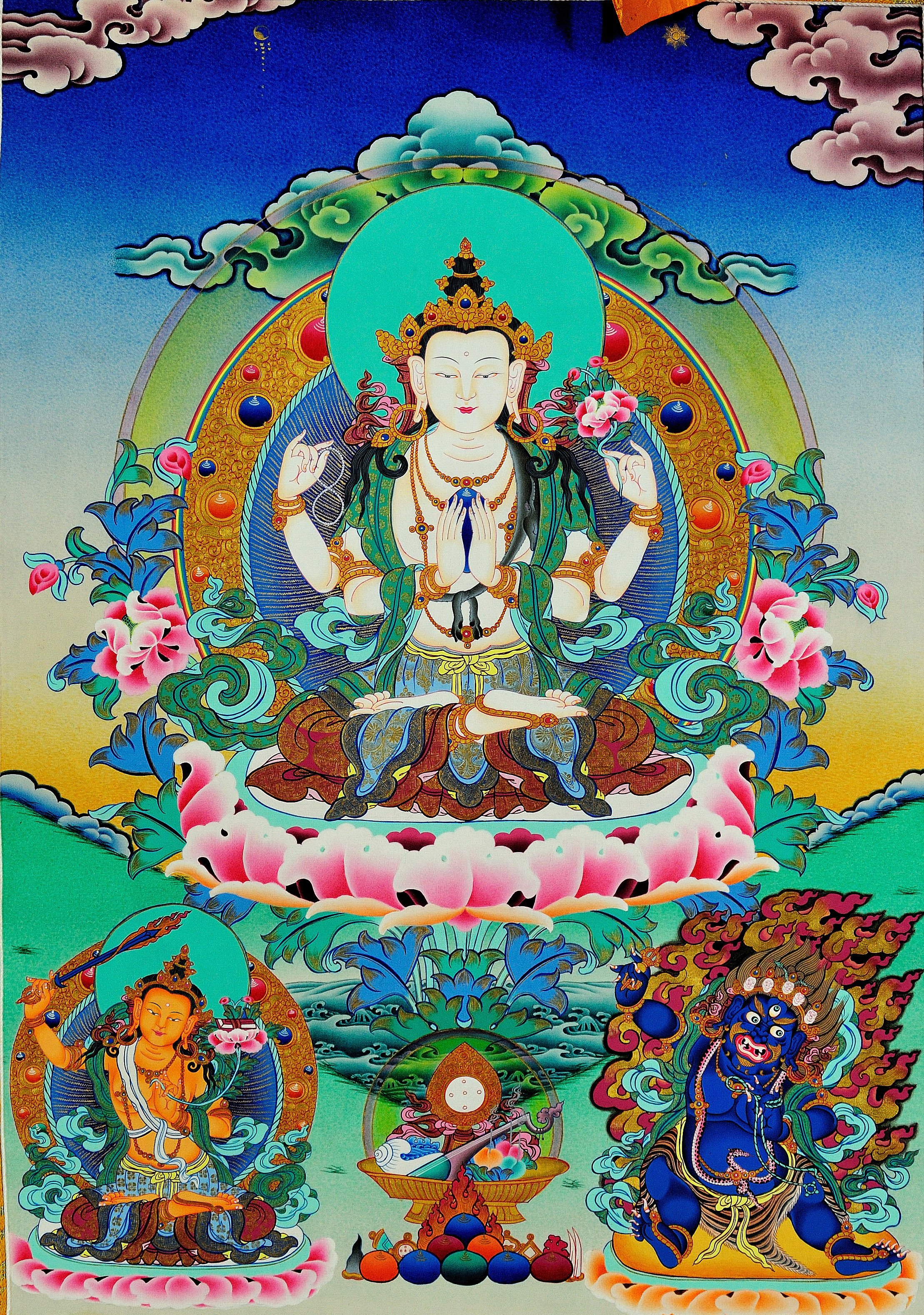Liberation Upon Seeing
Written by Lhundup
“The Tibetans use a particular phrase about the greatest of these religious artworks of having the power to generate, for the devotee, “Thongdrol”, meaning “Liberation Upon Seeing”.
It is meant to turn the individual to look towards a clear spiritual path.”
Thangka paintings are perhaps the most iconic and instantly recognisable pieces of Buddhist art in Tibet.
Believed to have originated within Tibet around the 11th century, these paintings were meant to serve as a teaching and meditation tool for spiritual practitioners.
These vertically oriented scrolls are either painted on a cotton canvas or crafted as silk appliqués.
Often depicting deities, spiritual masters and esoteric symbols, Thangka paintings are representations of spiritual reality and historical events.
Originally taught and painted only by ordained monks, over the years, they have come to be painted by lay painters.
The Tibetans use a particular phrase about the greatest of these religious artworks of having the power to generate, for the devotee, “Thongdrol”, meaning “Liberation Upon Seeing”.
It is meant to turn the individual to look towards a clear spiritual path.
Process, Composition and Artist
Thangka paintings come in various sizes and types.
The smallest ones are only a few centimetres wide and are used as initiation cards for novice monks.
The giant festival Thangka, usually appliqués, are tens of metres long and are only displayed in monasteries on special occasions.
The most common Thangka paintings are fairly small and measure between 20-50 centimetres high.
The composition of a Thangka painting is elaborate and highly geometric. Filled with symbolism and allusions, all elements are laid out in a systematic grid of angles and lines.
As religious artwork, the composition and figures must be in accordance with the strict guidelines laid out in the Buddhist scripture.
Stance, gesture, mood, colour and motifs- all have great significance in Buddhist art.
Deities and their attributes are identified through these elements.
The Thangka artist undergoes a long and rigorous training before they are able to produce an acceptable piece.
A traditional apprenticeship lasts 5-7 years.
It involves mastery of many demanding techniques and formal iconography rules laid down by generations of Tibetan Masters.
The artist learns to prepare everything from scratch; from the canvas preparation using animal glue, grinding colours from natural stone pigments, applying details in pure gold, to mounting the finished work in silk brocade.
The creation of a Thangka painting involves skill and care at each stage.
It requires meticulous detail and exquisite artisanship.
True to the teachings of non-attachment and emptiness, Thangka artists very rarely sign their pieces.
A completed Thangka painting must be consecrated by a spiritual master.
History and Influence
The beauty of the Thangka painting, apart from its aesthetic value, is the fact that it emerged as a result of the historical confluence of different cultures and influences.
The lining and measurement, costumes, implementations and ornaments are mostly based on Indian styles.
The drawings of figures have strong Nepalese influence and the background scenes are derived from Chinese styles.
The iconographies have hints of Kashmiri influences as well.
By assimilating the best of these influences, the Tibetans drew on their traditional methods and processes to create this unique and distinctive art.
“A Vajrayana or Tantric Buddhist practitioner uses the Thangka image of their meditation deity (Yidam), as a guide.
They visualise themselves as being that deity, thereby, internalising the Buddha qualities. ”
Significance and Meditation
One of the most intriguing aspects of Tibetan culture is the religious artwork.
Why are these so important?
In a nutshell, the Tibetan way of life; tradition, culture and arts are deeply rooted in the practice of Buddhist teachings.
In every form of Tibetan art, be it painting, sculpture and architecture, every element is highly symbolic and unique.
Most importantly, Thangka paintings are used as a mediation tool to help bring one further down the path to enlightenment.
A Vajrayana or Tantric Buddhist practitioner uses the Thangka image of their meditation deity (Yidam), as a guide.
They visualise themselves as being that deity, thereby, internalising the Buddha qualities.
Perhaps the value of these religious paintings can be gauged by the fact that for the Tibetans, these murals, paintings and mandalas serve as a gateway to Buddhist education even before they learn to read or write.
Traditionally, spiritual masters and mendicants used to travel with a Thangka painting and teach about the Wheel of Life or the Twelve Deeds of the Buddha.
These devotional images act as the centrepiece during a ritual or ceremony and are often used as mediums through which one can offer prayers or make requests. ◼︎
ABOUT THE AUTHOR
Lhundup is a Traditional Tibetan Thangka artist who has an MFA (Master of Fine Art) in Tibetan traditional painting from CIHTS (Central Institute of Higher Tibetan Studies). He is currently a staff member of well known Norbulingka Institute, furthering the knowledge and practical applications of the art.
He is well versed not only in Tibetan art forms and theory, but also in history, Buddhist philosophy, and the language.


